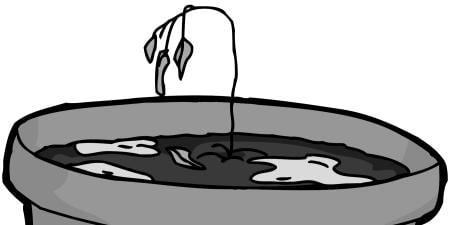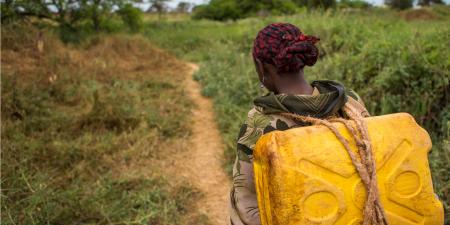Abstract
In this case scenario, a medical student, Jenny, is conducting congenital heart disease research in a resource-limited setting faced with water insecurity. She has concerns about how ethical it is for her to conduct advanced clinical research in a region with more basic health needs. The first commentary argues that advanced clinical research in resource-limited settings follows the ethical principle of beneficence and interactional justice but violates the principle of distributive justice. The second commentary questions whether beneficence is enough, since the Belmont Report states that beneficence is the obligation to simultaneously reduce harm and increase benefit. It calls upon public health physician-scientists to think deeply about how to involve communities in their research—and how to insert themselves into health policy development processes.
Case
Medical student Jenny arrives in a developing country optimistic and eager to participate in congenital heart disease research under a world-renowned clinician and researcher. Jenny stays with a local family in a village. Each morning, she hears the eldest daughter of her host family rise before dawn on her way to the local river. Balancing a large, filled-to-the-brim basin on her head, she travels daily with other women from her village to bring water to her home for drinking, washing, cooking, and cleaning.
Jenny wonders whether it makes sense from an ethical point of view to focus research in this community on developing highly specialized interventions for congenital heart disease when the people here only have reliable access to clean drinking water because a woman from each home—like many women in the world—spends much of her day retrieving it. As a guest, Jenny is aware that members of her host family make do with less water so that she can have a share of it. Additionally, some of the women have expressed concern that their access to their current clean water source could be limited in the future, due to contamination threats from upstream farms and local petroleum extraction as well as potential privatization of a large tract of currently public land that the women traverse to get to the water source.
Jenny wonders whether she and other members of her research team should begin participating in the water retrieval journey with the neighboring women. She also wonders whether their research efforts might be better devoted to helping members of this community achieve more certain water security over the long term.
Commentary 2
In 1974, the National Commission for the Protection of Human Subjects of Biomedical and Behavioral Research was convened to identify basic principles for the ethical conduct of research involving humans [1]. Five years later, the commission published the Belmont Report, which established three basic ethical guidelines for research: respect for autonomy, justice, and—the focus of this essay—beneficence. According to the Belmont Report, the principle of beneficence obligates researchers to minimize harm and “maximize possible benefits” to study participants and the community [1]. This essay addresses the challenge of what it means, on a practical basis, to embrace the notion that the ethically responsible public health physician-scientist should maximize community benefits within the context of research.
In this case, a medical student, Jenny, wonders if it is ethical for her to conduct research on congenital heart disease when those living in the community of study have such poor access to something as basic as drinking water. This case raises two important questions: (1) Should medical students pursue specialized research in resource-poor communities with water security concerns? (2) What is the researcher’s ethical obligation to community residents while conducting specialized research when residents do not have reliable access to clean drinking water?
I will address Jenny’s dilemma within the context of research on human health that seeks to provide the data, and the evidence, necessary to move the scientific process closer to providing a benefit. I write about Jenny’s case in the voice of an African American male and public health social scientist who is committed to health equity. I also write as one engaged in community-based participatory research (CBPR). CBPR is an especially appropriate research vehicle to use in exploration of beneficence because CBPR, perhaps more than other research approaches, is based heavily upon the ultimate goal of improving the social, political, and health conditions of the communities within which research is conducted. CBPR also requires researchers to ensure that the research provides benefits equally to the scientists, study participants, and community members [2, 3]; in fact, CBPR is ultimately a social change strategy [4]. However, conducting research that so clearly emphasizes community change to improve community health is a tall task.
If Jenny’s challenge sounds familiar, it is because it is hauntingly similar to the ongoing unnatural disaster in Flint, Michigan. Both communities are challenged by water insecurity and are under-resourced financially. Both communities have attracted the attention of researchers and, as a result, must confront the question of whether, and how, research actually benefits study participants and the broader community. While water insecurity has received the bulk of public attention in Flint, some research investigators are working on other health problems, such as heart disease, similar to Jenny. It is also very apparent that those researchers in Flint must, in some way, address the issue of water insecurity, just as Jenny must.
Though similar to Flint, Jenny’s situation is not exactly comparable. For example, Jenny’s heart research is not directly related to water insecurity and does not seem to have any immediate or direct benefit to the community in which she is working. Nevertheless, by virtue of her living in the area, Jenny cannot avoid consideration of the impact that water insecurity has on her community responsibilities.
As mentioned, much, but certainly not all, of the research conducted in Flint bears directly on water insecurity, and, in some respects, Flint has benefitted from that research. It is clear that research played a vital role in drawing attention to the most recent episode of the ongoing water “crisis” [5]. In Flint, if it were not for the research showing high levels of lead in the water combined with the analysis showing an association between lead in the water and lead in children’s blood [5], there may never have been the level of community outrage that mobilized the political action that has ensued. Research conducted in Flint has, to some extent, benefited city residents by providing scientific evidence consistent with community knowledge that the water was damaging to residents, especially children. Unlike the beginning of the crisis, when many doubted, refused to consider, or even denied that lead in the water was damaging the health of Flint residents, presently everyone believes this to be the case. However, this is an important but modest victory. The reality is that many Flint citizens do not fully trust researchers or governmental officials. Nor do they believe that their water is safe to drink [6]. In short, the research conducted in Flint has yet to deliver on the ethical obligation of maximizing community benefits for the residents of Flint [7]. Flint residents are still waiting for research to deliver a solution to the water crisis. This remains a work in progress.
Herein lies the difficulty with beneficence. It is an aspiration that can go unfulfilled. Research participants and the community residents they represent certainly deserve some benefits from research; and the Belmont Report clearly demands as much. The problem is that communities often have to wait to obtain those benefits. Even when there is benefit, it often takes decades before an intervention program is deemed effective enough to be widely disseminated [8, 9]. Offering study participants financial incentives is certainly a benefit. However, it must be made clear during the recruitment and consenting process that any potential community benefits are heavily dependent upon years of subsequent work, follow-up studies, and scientific debate.
Given this state of affairs, what is Jenny or, for that matter, any community-based research scientist to do regarding benefitting the community within which they are working? I offer three paths for consideration.
First, public health physician-scientists need not conduct research. Unlike most researchers, they have the option of patient care. Since, in my experience, most medical students are attracted to the profession because of a desire to help people by treating and healing their wounds, they need not engage this particular research ethics challenge. The treatment benefits are more obvious and immediate.
A second option is for the public health physician-scientist to remain primarily in the world of academia, conducting basic and applied research. It is not necessary for any research scientist, clinically trained or otherwise, to join the politically driven community activism characterized by CBPR. In fact, it might be the case that all research, no matter how far removed from local residents, may eventually provide community benefits, albeit indirectly. Some physician-scientists focus on the quest for knowledge and may not be especially concerned with the practical application of that knowledge or how their research affects community residents. As a result, they are less encumbered by the challenge of how to maximize benefits for marginalized and economically oppressed communities.
I am promoting a third option. Medical students, like Jenny, can forge a transdisciplinary research identity that places medicine more directly within the context of public health and CBPR. Medicine can be a natural ally with the CBPR public health approach to community change. It is true that public health is primarily involved in prevention and medicine primarily in treatment. However, public health and medicine overlap; they share much common ground.
I propose three recommendations regarding this case. First, both medical and public health approaches are equally necessary. As a medical student, Jenny must use her biomedical expertise to help build knowledge about congenital heart disease while also participating in the broader public health activities of water safety and retrieval. Periodically, Jenny must step away from the individual study participants in order to more clearly view the big picture of how both medical healing and community research exist within a larger ecological framework. By “stepping away,” I suggest that there is an advantage to periodically engaging a broader perspective that considers the role of economic, political, gendered, and racial factors in the production of chronic disease [10]. The limitations of patient care for improving population health demands that medical students like Jenny expand beyond individual patient care to obtain additional training, such as a certificate in public health or a second graduate-level degree (e.g., MPH, MS, PhD).
Second, there is a preferred sequence to helping. Helping the community to address, reduce, or eliminate water insecurity must be the first priority, although this need not be addressed within the context of research or patient care. Jenny, like all of us, has a civic responsibility to address such basic necessities before, or at least in conjunction with, treating and/or conducting research on heart disease, diabetes, hypertension, depression, or cancer. Research and social activism are separate activities, although they are closely linked within CBPR. Jenny’s study is not CBPR. That does not, however, release her from the responsibility of getting involved in such an important community problem. To be specific, Jenny should help the women in her community carry water.
Third, as research scientists, we must do more than reduce harm. Researchers should do as much as possible to maximize immediate and long-term benefits to the residents from the communities where studies are conducted. A good place to start is by asking community residents which problems need to be studied and why. Simply ask, “How can we help?” Researchers also need to share executive decision-making power with community residents. This means the research team, and especially the principal investigator, must include community representation beforesubmitting research proposals. In this way, public health physician-scientists like Jenny can ensure that community residents are equal partners in the initial research planning process. And in this way, community members can counsel, guide, and educate researchers about how best to identify and incorporate tangible community benefits, such as budget line items, appropriate respondent incentives, hiring local talent as research assistants, and the appropriate use and dissemination of research findings.
In conclusion, rigorous research is the basis of evidence. Everyone deserves access to evidence-based treatment and intervention programs. For this to happen, public health physician-scientists must do at least two things: they must invite community members to help shape research proposals, and they must insert themselves into the health policy process. This is the path to community beneficence.
References
-
National Commission for the Protection of Human Subjects of Biomedical and Behavioral Research. The Belmont Report: ethical principles and guidelines for the protection of human subjects of research. https://www.hhs.gov/ohrp/regulations-and-policy/belmont-report/index.html. Published April 18, 1979. Accessed August 29, 2017.
- Israel BA, Schulz AJ, Parker EA, Becker AB. Review of community-based research: assessing partnership approaches to improve public health. Annu Rev Public Health. 1998;19173-202.
- Shore N. Re-Conceptualizing the Belmont Report: a community-based participatory research perspective. J Community Pract. 2006;14(4):5-26.
-
Minkler M, Garcia AP, Rubin V, Wallerstein N. Community-based participatory research: a strategy for building healthy communities and promoting health through policy change. Oakland, CA: PolicyLink; 2012. http://www.policylink.org/mwg-internal/de5fs23hu73ds/progress?id=q1IWNPR1ZcqoWtRQJI-QciWGxBCd5RZXvXXwkJmb3IM,&dl. Accessed August 29, 2017.
- Hanna-Attisha M, LaChance J, Sadler RC, Champney Schnepp A. Elevated blood lead levels in children associated with the Flint drinking water crisis: a spatial analysis of risk and public health response. Am J Public Health. 2016;106(2):283-290.
-
Fonger R. With Flint water improving, officials at town hall work on convincing residents. MLive. January 11, 2017. http://www.mlive.com/news/flint/index.ssf/2017/01/flint_town_hall_on_water.html.Accessed August 29, 2017.
- Sadler RC, LaChance J, Hanna-Attisha M. Social and built environmental correlates of predicted blood lead levels in the Flint water crisis. Am J Public Health. 2017;107(5):763-769.
-
Brownson RC, Colditz GA, Proctor EK, eds. Dissemination and Implementation Research in Health: Translating Science to Practice. New York, NY: Oxford University Press; 2012.
- Green LW, Ottoson JM, García C, Hiatt RA. Diffusion theory and knowledge dissemination, utilization, and integration in public health. Ann Rev Public Health. 2009;30151-174.
-
Cockerham WC, Hamby BW, Oates GR. The social determinants of chronic disease. Am J Prev Med. 2017;52(1)(suppl 1):S5-S12.



